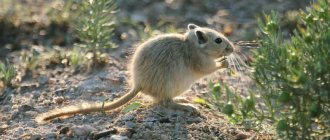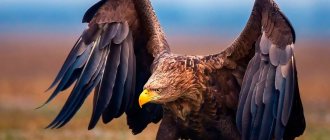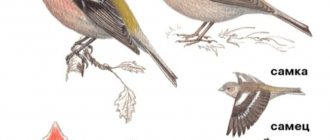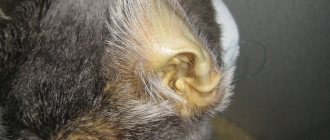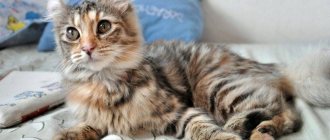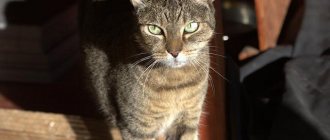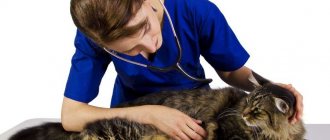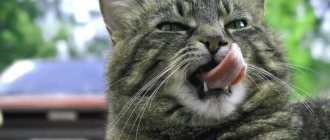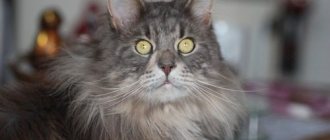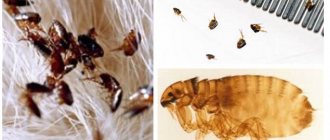The European wild forest cat is a predator whose origin story dates back to the Pleistocene era. These animals differ from pets not only in their habits, but also in their appearance. The European wild forest cat is several times larger in size than a domesticated pet.
Some animals are in danger of extinction. This breed already has 23 subspecies, and only some of them may disappear. Wild cats differ from each other and live in different countries, so widespread inclusion of forest wild cats in the Red Book is almost impossible.
History of the origin of the breed
Wild cats as such appeared during the Pleistocene era, which ended 11.7 thousand years ago. Then the weather was extremely harsh, most of the time the Earth was cold. Sometimes there were relatively warm, favorable periods. In some places the weather changed rarely and dramatically, becoming either terribly hot or impossibly cold.
During the Pleistocene, many different species of animals appeared on Earth, many of which eventually died. This is due to the fact that the Pleistocene era ended with the Ice Age.
The exact date of the emergence of wild cats is not known. It is a well-established fact that they appeared on Earth before the Ice Age.
Wild cats survived the coldest period, after which they began to adapt to life in dense forests. The animals were able to settle in the forests, and still live there. Hence the name – forest cat.
From the name of the breed one can also understand that the first thing its modern representatives were brought to Europe. Previously, representatives of the species occupied a vast part of central Europe, now - western and eastern.
Previously, Russian forest cats lived on the territory of the USSR, mainly on the northeastern border with the Caucasus. Now wild cats remain in the Caucasus. And this does not in any way change the fact that forest cats are very rare in Russia.
There is a certain problem associated with the fact that sometimes forest cats mate with stray cats. Because of this, unclean offspring appear, threatening the entire species with extinction. The Scottish forest cat especially suffers from this problem. In other countries, there are much fewer mixed-breed cats.
Scientists say that there is no need to focus attention, since due to the appearance of non-purebred kittens, the species will not go extinct anyway. Despite this, the purebred breed is listed in the International Red Book.
Norwegian Forest Cat
The Norwegian Forest Cat is an attractive cat with a beautiful coat and good looks. This cute cat originated many centuries ago in Northern Europe. Thus, it is known in its homeland as Norsk Skogkatt, which literally means "Norwegian Forest Cat". Although it is a natural breed, it is not a wild cat. At first glance, it was quite common as a domestic cat in Norway before it was officially appreciated and recognized in Germany in the late thirties.
Norwegian forest cat appearance
The cat's appearance is an adaptation to the winter climate of Scandinavia. The coarse, two-layer coat protects him from the cold, and the large size retains heat better, as is the case with the Maine Coon. In fact, many consider the Norwegian Forest Cat to be the ancestor of the Maine Coon, although the former is slightly smaller in size.
Males reach a weight of about twenty pounds sometimes, with females being half this size. The coat exists in a variety of colors and patterns, and is woolen and glossy on the surface.
The profile is straight and the hind legs are longer than the front. The face is triangular with almond-shaped eyes, tufted ears and an overall expression that is quite cute.
A slow-growing breed of Norwegian Forest Cats, it takes four to five years for a Forest Cat to fully develop. They are compact and independent felines and are quite capable of moving outdoors and withstanding cold climates. Their excellent bushy tail and impressive mane are not only a source of magnificent beauty, but also effective protection in low temperatures.
Character
Intelligent and playful, Norwegian Forest cats share many qualities with Maine Coons. They are sweet but not overly demanding and are quite adept at grooming and maintaining themselves without being cramped in a large home. These robust animals are good climbers and are well built for an active lifestyle. Natural sportsmen, Norwegian forest cats love to explore counters, bookcases, and the highest tops of their cat trees. Wegies are active and playful and retain their cheerful spirit into adulthood. But don't be fooled by the breed's impressive muscles and all-weather exterior. They are sweet, friendly and family-oriented, and they love their human companions. Despite the wild years in the forests of Norway - or perhaps because of it - they are more likely to cuddle than run away. Because of these harsh years of survival (perhaps), nothing bothers them, either. They take on new people and new situations in stride. Forest cats are a strong and quiet type of cat. On the contrary, they are great purrs, especially when sitting next to their favorite people. Sociable, they tend not to commit to one person, but rather to love everyone unconditionally and enthusiastically. The friendly, calm Norwegian Forest Cat is an ideal choice for families with children. He loves the attention he receives from children, who treat him politely and with respect. And he doesn't mind playing dress up or riding in a baby stroller. He is happy to live with other cats and small dogs due to his friendly disposition. Introduce pets slowly and under controlled conditions so they learn to get along with each other.
Coloring
The forest cat comes in almost all colors and patterns, with or without white. Except for chocolate, lavender or lilac or a pointed pattern like the Siamese. The Norwegian Forest Cat's distinctive double coat varies in length depending on the time of year. A cat goes through a spring shedding when it sheds its winter coat. It then sheds its coat again in the fall when the summer coat sheds. At this time of year, thorough brushing is essential unless you want seasonal layers of cat hair. During the rest of the year, the forest cat requires minimal grooming as it retains its coat, perhaps remembering those harsh winters.
Health and care
Both purebred and mixed breeds have a variety of health problems that may be genetic. Norwegian Forest Cats are generally healthy, with a long lifespan of 14 to 16 years. The following diseases have been seen in the breed:
- Glycogen storage disease IV, a rare inherited disorder that affects glucose metabolism. Most kittens with this disease are stillborn or die within hours of birth, but sometimes a kitten does not show signs until about 5 months of age and usually dies within a few months. DNA testing is available that can identify affected and carrier cats.
- Hypertrophic cardiomyopathy, a form of heart disease that is inherited in some cat breeds such as the Maine Coon. Heredity has not been proven in the Norwegian Forest Cat.
- Polycystic kidney disease, a genetic disease that gradually destroys the kidneys. There is no DNA test for the disease for Norwegian Forest Cats, but the disease can be detected by ultrasound at an early age of 10 months.
- Retinal dysplasia, an eye defect that causes spots on the retina but does not impair a cat's vision.
History of the Norwegian Forest Cat
The Norwegian Forest Cat originally lived in the forests of Norway and was known by local farmers as a large, hardy animal with excellent hunting skills.
Breeders did not breed the cat until after World War II (1939-1945), when it almost disappeared.
The Norwegian Forest Cat, called skogkatt (forest cat) in Norway, is a naturally occurring breed. Despite its wild appearance, it is not a descendant or hybrid of any wild cat species.
Forest cats probably came to Norway from Europe, and descendants of domestic cats were brought to northern Europe by the Romans. It developed from a mutation, a change in the breed's characteristics that occurred naturally and not through a selective process by cat breeders.
Norse mythology mentions huge Norse cats in its lore of the gods. In one tale, two of these cats pulled the chariot of Freya, the goddess of fertility.
The Norwegian Forest Cat is believed to have been around for a long time, as there are several references to large, long-haired cats in Norse mythology. Estimates of when these cat tales were written vary greatly. Most of the Norse myths were passed down by oral tradition and were finally written down in the so-called Edda poems, written sometime between 800 and 1200 AD. These myths suggest that domestic cats have been in Norway for hundreds, perhaps thousands, of years. Whether cats depicted in myths are forest cats is up for debate.
When cats arrived in the northern countries, most likely with settlers, traders or crusaders, the breed's ancestors were likely short-haired, since the cats transported by the Romans originated from Egypt (usually) and were short-haired. The cats survived and adapted to the harsh climate in time. Northern Norway, where the sun never sets from May 12 to August 1, and where winter nights are correspondingly long and dark, has proven to be a harsh test for these cats. Over centuries of roaming the Norwegian forests, they developed long, dense, water-resistant coats, hardy builds, intelligence, and refined survival instincts.
The first attempts to recognize the forest cat as a special breed began in the 1930s. The first Norwegian cat club was founded in 1934, and in 1938 the first forest cat was exhibited at an exhibition in Oslo, Norway.
The Second World War, however, brought into question all breeding and showing of cats, and after the war the breed came close to extinction. Crossbreeding with the Norwegian Shorthair domestic cat (called the Housecutt) threatened the existence of the wildcat as a pure breed. It was not until the 1970s that cat fanciers in Norway began a serious breeding program to preserve the Norwegian Forest Cat.
The Forest Cat was introduced to the United States in 1979. That same year, a small group of American fanciers founded the Norwegian Forest Cat Fanciers' Association and began working to have the forest cat recognized by North American cat registries.
Appearance
In terms of external parameters, a wild forest cat resembles an ordinary domestic cat. It is distinguished by its massiveness (the weight of males reaches 8-9 kg) and high fur. Females are relatively small in size, as their weight rarely exceeds 6 kg. Some subspecies of wild cats reach 14-15 kg. The closest breeds to forest animals are the cat breeds such as the swamp lynx and manul.
This breed has two main names, including: Central European (or European) forest cat and the Latin designation of the species - felis silvestris silvestris (translated - wild cat). Sometimes these names are combined with each other, which is not a mistake.
Even the name - forest cat or felis silvestris - obliges the animal to have the appropriate coloring. These cats are characterized by gray, smoky and brown fur. Along the ridge there are darker stripes that vaguely resemble the pattern on the skin of an ordinary lynx.
This coloring helps the animal camouflage. Almost all varieties of forest cat species have tall and dense fur. Previously, this saved animals from extreme cold, so we can say that this detail of appearance was formed in the process of evolution.
Representatives of the breed have the traditional cat "whiskers", but no "eyelashes". The ears are medium-sized, widely spaced, without tassels at the tips. The teeth are small but sharp, like those of many predators.
Description of wild forest cat:
- the eyes are quite close-set, often green, less often amber-green and brown;
- height at the withers - from 30 to 35 cm, body length without tail - from 45 to 95 cm (tail 25-30 cm);
- the head is small, with a neat, slightly elongated nose and massive jaws;
- on the tail there is a pattern in the form of dark rings, the tail itself is shorter than that of a domestic cat, more fluffy and has a blunt end;
- The hind legs are more powerful than the front legs, helping the animal to push off strongly from the surface (jump high).
Character and habits
The Central European or European wild forest cat is not friendly. These cats do not particularly recognize even their relatives, let alone other predatory animals. Forest cats can get their own food; they don’t have to flock together (they don’t do that). Animals can only gather during the mating period.
Wild cats often sleep the whole day, often they go hunting only in the evening and at night. They see well in the dark, like other members of the cat family.
Any cat deliberately marks its territory, because it is a predator - this is how it shows its dominance. Animals of this breed do not like strangers in their area. In its wild life, the Central European cat does not like slush and cloudy weather, as this greatly interferes with hunting.
You should not get in the way of the animal, otherwise you may become familiar with its sharp claws. Sometimes wild cats “privatize” places close to the treetops. They climb the trunk and branches with the help of their claws, usually hidden in soft paws.
They also use their claws to catch prey. If a forest cat lives in a zoo, then he definitely needs a spacious enclosure with imitation tree trunks or with live plants.
Life in captivity
Since the wild forest cat is listed in the Red Book, its purchase and sale is illegal. Consequently, in captivity this wild cat can only be found in a zoo or nature reserve.
Conditions of detention
This exotic pet loves space, so it is better to keep it in a small fenced area or by setting up an enclosure. At the same time, you need to remember that the animal jumps 3 meters in length, so it is better to make the fence a little higher. The enclosure must have trees or logs for the pet to climb, as it did in the wild. In a zoo, the conditions for keeping an animal should be the same.
Of course, in a reserve, where an animal feels like in the wild, it lives better than in a zoo.
In captivity, cats reproduce well. Thanks to their maintenance in nature reserves and zoos, the population is preserved.
A forest cat's enclosure should contain trees or logs that it is used to climbing in the wild.
Caring for such a pet is not difficult - it is enough to comb the animal’s fur weekly and bathe it monthly (but this should not be done often). The wild forest cat does not like change, so “his things” do not need to be swapped. These animals are quite strong physically, but they still need to be visited by a veterinarian every six months, who will help eliminate the following diseases characteristic of the breed:
- hypertrophic cardiomyopathy (heart disease);
- polycystic kidney disease;
- retinal dysplasia.
It is not recommended to castrate or sterilize a wild pet, as it does not tolerate anesthesia well.
A friend of mine constantly sends photographs of her wild forest cat, since she lives far away and I have no opportunity to see the animal. A friend says that her pet’s character is not very flexible, but she attributes this feature to the animal’s wild nature. The girl says that, on the contrary, this suits her. A friend of hers bathes her pet quite rarely, and practically doesn’t care about its appearance at all, which is very convenient for her, since she, one might say, “lives” at work. And the cat, although with character, misses her, but lately he has become accustomed to this routine. The main problem is feeding the purr - my friend chose natural food for him, which has to be prepared in advance. Usually this takes up a decent part of the weekend, which, of course, makes the girl indignant. However, according to her, it’s worth it, because a real predator lives next to her. A friend arranged a special house for the animal, reminiscent of a small enclosure. Sometimes she lets the cat out for a walk around the outskirts of her property, but she is very afraid that the wild nature will overpower her love for her owner, and the pet will run away.
Range and habitats
Wild cats were popularized throughout central and western Europe. For some time they lived in southern countries - in Spain and Italy. Animals also lived in the territory of Asia Minor.
Today, forest cats can be found in the Caucasus and Ukraine. Also, animals invariably live in Europe. Forest cats surprisingly love to go to the mountains, to a height of 2-3 km above ground level. Central European cats have “settled” in the Caucasus since the times of the USSR.
Not long ago, a representative of this breed was spotted in a completely unexpected place. A forest cat was walking in Belarus, which is completely unusual both for this species and for the inhabitants of the country. The fact is that the breed was considered extinct for 90 years. Therefore, many believed that Belarus and the wild cat were simply incompatible things. Well, then the animal was caught in the lens of a photographer.
Forest cats avoid almost all terrestrial predators, but wolves and foxes are the most dangerous for them. That's why cats prefer to go to the mountains or climb trees. They can stay in such a shelter for more than one month if they can get food for themselves.
In Russia there is one subspecies of furry savages - Felis silvestris caucasica (translated as Caucasian forest cat). And they are quite rare.
Features and habitat of the velvet cat
The sand cat is named after the French general Margueritte, who led the Algerian expedition in 1950. During the expedition, this handsome man was found (from the Latin: Felis margarita).
Its peculiarity lies in the fact that it is the smallest predator of all wild cats. The length of an adult animal reaches only 66-90 cm, 40% of which is allocated to the tail. The sand cat weighs from 2 to 3.5 kg.
It has a sandy coat color corresponding to its name, which allows it to camouflage itself from ill-wishers in its environment. It is better to start the description of the dune cat with the head, it is large with fluffy “whiskers”, the ears are protruded to the sides to prevent sand from blowing into them, in addition, they also serve as locators in order to better hear prey and approaching danger, and, of course, they serve as a heat exchanger.
The paws are short, but strong, in order to quickly dig in the sand when building their burrows or tear apart prey hidden in the sand. Sand cats also have the habit of burying their food if it is not eaten, leaving it for tomorrow.
The feet, covered with hard hair, protect the predator from the hot sand; the nails are not very sharp and are sharpened mainly by digging in the sand or by climbing on rocks. The fur of cats is sandy or sandy-gray in color.
There are dark stripes on the head and back. The eyes are framed and lined with thin stripes. The paws and long tail are also decorated with stripes, sometimes the tip of the tail has a dark color.
The velvet cat lives in arid areas with sand dunes and rocky places in the desert, where temperatures reach 55 degrees Celsius in summer and up to 25 degrees in winter. For example, the daytime temperature of sand in the Sahara reaches 120 degrees; one can imagine how these animals endure the heat without water.
Lifestyle and nutrition
The European wild cat is distinguished by its agility. If she senses danger, she will immediately climb a tree and hide from pursuit at a height. Forest cats can live not only among trees, but also near rivers.
They can find temporary shelter in abandoned hollows, holes, and sometimes even in large heron nests. As a rule, cats create shelters for themselves in winter to wait out the cold. At the same time, they do not stop hunting and are rightfully considered excellent hunters.
Cats often flee from an impending threat in places where there are many badger holes. Subsequently, they can use these holes as a home.
Animals most often wait out the day in the den, and go hunting at dusk. They hunt before sunset and at night, and then go back to their homes. It is noteworthy that during the period of shallow water, forest cats begin to feed on the inhabitants of reservoirs and rivers.
Reproduction
Cats gather together between the beginning of January and the end of March. Males in groups begin to hunt for the mother of their future offspring. In addition, the female is often pestered by simply stray cats who also want to mate with her.
Males fight among themselves from time to time. Fights occur both between males of the same species and with outbred cats. But in the end, not all the offspring turn out to be “pure”, since many females manage to mate with outbred males.
The father of the kittens is the male who shows his best side. That is, roughly speaking, the strongest and most resilient.
When a female becomes pregnant, she begins to look for the best place for the subsequent birth and maintenance of offspring. Cats very often settle in holes and hollows abandoned by their previous owners.
The female brings grass and feathers into the home, thereby making a kind of pillow for her children. She gives birth in 2 months, sometimes a little more time passes, but still the birth occurs in the spring - in April or May. Usually only 2-3 fluffy lumps are born, occasionally 4-5.
Newborn forest kittens are very weak and small, they weigh 200-300 grams. Therefore, the mother has to monitor them and feed them milk.
Forest kittens gain sight fairly quickly - in about 8-12 days.
At the age of a month, babies begin to slowly get comfortable and crawl around the house (at this time the cat should be especially attentive). At two months of age, kittens leave the house and go hunting with their mother. After this, the still small wild kittens begin to try to exist on their own, but their mother does not abandon them.
Reproduction and young
The mating season for wild cats occurs at the end of winter (February). Pregnancy lasts 65-70 days, and an average of 3 kittens are born in one litter. The mother feeds the cubs with milk for up to 4 months, and already from 2 months begins to teach them hunting skills. Young females reach sexual maturity by 10 months, males much later, only by 3 years.
Forest cat at home
Keeping a wildcat at home is not the best idea when it comes to purebred representatives of this species. The predator will simply feel uncomfortable living in the house. It is unlikely that it will be possible to keep wild cats in the city, since urban conditions are completely unsuitable for them.
Wildness is genetically inherent in these predators, so no trainer can correct this. Living with a forest cat will not be easy, especially if it was adopted at six months or one year of age.
The option of taming an animal is only possible in the case of a small (2-4 month old) kitten. In addition, do not forget that the forest cat breed has more than 2 dozen varieties, some of which are more domesticated due to the initial crossing of a wild animal with a stray cat.
It is better to buy from nurseries or experienced breeders. The cost starts from 15 thousand, but due to the rarity of clean individuals (especially in Russia and Belarus), a real predator will cost at least 35-40 thousand rubles. Forest cats live 12-16 years and are not prone to a large number of diseases, unlike ordinary purebred pets.
Features and habitat of the forest cat
As has already become clear, the forest cat is a generalized name for all wild mustaches. In order to narrow the choice, let’s “discard” the steppe and desert inhabitants. Let's study the forest ones. Hidden under the canopy of trees and on them:
Caucasian forest cat. Listed in the Red Book. According to the latest data, there are no more than 500 individuals in the form. They are dispersed along the western coast of the Caspian Sea and the forests of the Krasnodar Territory. There, Caucasian cats deftly climb trees, clinging with sharp and long claws. Another element of the species is water. The second name of the Caucasian mustachioed cat is the reed cat. Representatives of the species swim well and are found in coastal thickets.
The maximum weight of a Caucasian cat is 10 kilos, compared to the usual 6-8 kilos. The body length reaches 70 centimeters. The body itself is compact and strong, with thick and fluffy gray-beige hair. On top of them is a pattern of black stripes. The muzzle of a Caucasian cat is wide, slightly elongated with large and protruding eyes.
The Caucasian forest cat is also called the jungle cat
Amur forest cat. The smallest among Asian ones, and therefore the most acceptable at home. The length of the animal does not exceed 90 centimeters. 40 of them are in the tail. The weight of the mustachioed one is 3-4 kilograms. They have a muscular, elongated body with a small and elongated head. She has a long, drooping mustache. They are whitish, as are the pair of stripes running from the eyes to the forehead. The rest of the cat's color is brownish-gray.
Far Eastern forest cats are found in the Primorsky and Khabarovsk territories. Outside Russia, the species is represented in Nepal, China, Japan, Burma, Sumatra, Pakistan and Bloneo.
African golden cat. In Russia it is found only in houses. Animals are brought from the equatorial forests of Africa. There, kittens stretch up to 120 centimeters in length, gaining up to 14 kilograms of mass. At home, golden whiskers tend to be smaller.
The name of the species is associated with the orange-sunny color of the fur. It is smooth and short. The beauty of the cat is attractive, but due to their secretive lifestyle, there is little information about Africans. Therefore, having an animal at home is considered a risk. In nature, a golden cat is capable of killing a small antelope. As they say, don’t put your finger in your pet’s mouth.
Norwegian forest cat. Brought to Scandinavia by the Vikings. They put cats on ships to catch rats carrying the bubonic plague. It is believed that Norwegians are descendants of Turkish Angoras and are related to the Siberian cat. All 3 species have fluffy, thick, soft fur and wide faces with pointed ears. All three felines are native breeds. They are officially domesticated, although part of the population continues to live in the wild.
Cats that were once brought to Norway have settled throughout the continent. The concept of “European forest cat” appeared. This is the second name of the species. Its representatives weigh about 7 kilograms, and in length, including the tail, reach 50 centimeters.
The Norwegian Forest Cat is also called the European Cat.
Asian leopard cat. Wild forest version of the mini-leopard. The same spotting, grace, activity, but in the size of 5-7 kilograms. From the name of the species it is clear that it lives in Asia. At home, representatives of the species are peaceful. However, increased activity and low learning ability mean keeping them in an enclosure.
Spotting is a distinctive feature of many forest cats. The color is considered wild; it is found in domestic cats only in the case of native breeds. One example is the Kurilian Bobtail. He has a short tail. This is the result of a natural genetic mutation. The size of the cat is indistinguishable from that of a domestic cat. Brown spots are scattered on the animal's golden-brown coat. The spectacular animal has been tamed, but its wild habits still make themselves felt. The Kurilian Bobtail is difficult to train, willful, and prone to escape.
The spots on wild cats can merge into stripes. Domestic baleens do not have them. Wild colors are due to camouflage in nature. Those who are domesticated, but have retained the zoomorphic print, are still close to it.
